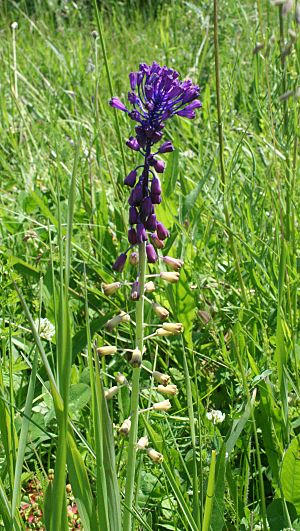Leopoldia facts for kids
Quick facts for kids Leopoldia |
|
|---|---|
 |
|
| L. comosa in Slovakia | |
| Scientific classification |
|
| Kingdom: | Plantae |
| Clade: | Tracheophytes |
| Clade: | Angiosperms |
| Clade: | Monocots |
| Order: | Asparagales |
| Family: | Asparagaceae |
| Subfamily: | Scilloideae |
| Genus: | Leopoldia Parl. |
| Synonyms | |
|
|
Leopoldia is a group of plants that grow from bulbs, like onions or tulips. These plants live for many years (they are perennial). They belong to the Asparagaceae family, which also includes asparagus!
You can find Leopoldia plants all around the Mediterranean region and nearby areas. This stretches from the Canary Islands to Iran.
Leopoldia plants used to be grouped with another plant called Muscari. Both are often called "grape hyacinths" because their flowers look a bit like bunches of grapes. Their flowers grow in a tall spike or cluster, with the top flowers often brighter than the ones lower down.
Contents
What Leopoldia Looks Like
Leopoldia plants are usually taller than Muscari. Their flowers are also more spread out on the stem, making the cluster look more open.
The flowers at the bottom of the stem are the ones that can make seeds. They are often shaped like small pots or tubes. They can be white, yellow, green, or brown, but never blue. These flowers have little "shoulders" near their opening. The opening itself is smaller than the rest of the flower and has tiny "teeth" around it. The color of these "teeth" helps scientists tell different Leopoldia species apart.
At the very top of the flower cluster, there's usually a bunch of bright violet, blue, or pink flowers. These top flowers don't make seeds; they are just for show!
How Leopoldia Got Its Name
Plant names can sometimes be a bit tricky! In 1819, a botanist named William Herbert first thought of using the name Leopoldia for a different plant group. However, another botanist, Filippo Parlatore, later used Leopoldia in 1845 for the plants we are talking about here.
To avoid confusion, scientists decided that Parlatore's use of Leopoldia would be the official one for these grape hyacinth-like plants. This means Leopoldia is now a "conserved name," which is a special way of saying it's the correct and accepted name for this group of plants.
Different Kinds of Leopoldia
As of 2014, scientists recognize 12 different types, or species, of Leopoldia plants. Here are some of them and where they grow:
- Leopoldia bicolor - Found in Egypt, Israel, Palestine, Lebanon, and Syria.
- Leopoldia caucasica - Grows in the Caucasus region, Turkey, Iraq, and Iran.
- Leopoldia comosa - This is a very common one! It grows all around the Mediterranean and Europe, from the Canary Islands to Iran. You can even find it as far north as Great Britain, Denmark, Poland, and Ukraine. It has also started growing in parts of Australia and the USA.
- Leopoldia cycladica - Found in Greece, including its islands.
- Leopoldia eburnea - Grows in Egypt, Palestine, and Israel.
- Leopoldia ghouschtchiensis - Found in Iran.
- Leopoldia gussonei - Grows on the island of Sicily.
- Leopoldia longipes - Found from the Caucasus south to Sinai and the Persian Gulf.
- Leopoldia maritima - Grows in North Africa and southwest Asia, from Morocco to Iran, and also in Crimea.
- Leopoldia tenuiflora - Found from Germany and Italy east to Ukraine, Iran, and Saudi Arabia.
- Leopoldia tijtijensis - Found in Iran.
- Leopoldia weissii - Grows in Greece and Turkey.
How People Use Leopoldia
The bulbs of one species, L. comosa, are actually eaten in different parts of the world!
- In Iran, they are pickled and called "moosir." People often eat them with yogurt.
- In Greece, they are called "volvoi," which simply means "bulbs."
- In some regions of Italy, like Basilicata and Apulia, they are known as "lampascioni," "lampasciuni," or "lamponi."
These bulbs are considered a special heritage food in Italy and are even included in the Ark of Taste catalogue. This catalogue lists unique foods from around the world that are worth preserving.
See also
 In Spanish: Leopoldia para niños
In Spanish: Leopoldia para niños

